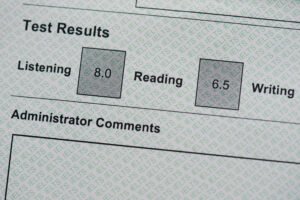In the last year, a growing collection of polls has suggested grim prospects for the public perception of higher education. Most notably, Gallup found in 2023 that only 36 percent of Americans have “a great deal” or “quite a lot” of confidence in higher education—down about 20 percentage points from 2015.
At the same time, many higher education institutions have faced sharp drops in enrollment and intense political scrutiny, leading media organizations to link the drop in confidence to a decline in both the perceived value of a college degree and the number of prospective students.
But analysts from the left-leaning think tank New America argue in a policy brief released Monday that that might not be the case after all, and that rumors of higher education’s demise have been greatly exaggerated, to borrow from Mark Twain’s famous words to the New York Journal.
Yes, Americans are less confident in colleges and universities and increasingly questioning whether a degree is worth the investment of time and money. But they still value higher education, the brief argues; the reasons behind enrollment declines are far more nuanced than journalists often frame them to be, and the polls reflect the public’s biases and misconceptions.
Kevin Carey, New America’s vice president of education and work and co-author of the brief, worries that if the media continues to paint the results of public polls with a broad, negative brush, it could impact allocation of the funds needed to address the systemic flaws that do exist within higher ed.
“Institutions are competing for resources, and if policymakers believe that there is a declining need for higher education, they might see that as a reason to not support it,” Carey said. “While there certainly have been changes … people still really both need and want to go to college and for it to be affordable.”
Outside policy and data experts generally agree that public opinions of higher education are highly nuanced and have, at times, been oversimplified.
Ben Cecil, senior education policy adviser at Third Way, a center-left think tank, said looking at recent higher education survey data is like walking and chewing gum at the same time—and Americans are smart enough to do both.
“There’s a real difference between trust and value, and the definitions of those two have often been conflated when they’re actually two different things,” he said. “You can not trust something as much as you would like to, but you can also still see that it has value.”
But others believe the trend of deteriorating public trust should not be overlooked altogether, arguing that confidence in an institution should be viewed independently from the perceived value but that it’s also important to note where there is overlap.
“Dismissing the confidence metrics and totally divorcing the relationship between them and their impact on enrollments would be a significant mistake for the industry,” said Stephanie Marken, a senior survey research partner at Gallup. “When we dismiss the confidence metric as well as the reasons people tell us they’re not confident, we lose important opportunities to actually improve.”
Other Variables at Play
Carey and co-author Sophie Nguyen argue in the brief that many factors besides public views of higher ed impact college enrollment, including demographics, the state of the economy and even how people define the terms “confidence,” “faith” and “value.”
So while some of the past decade’s enrollment decline could be related to tarnished trust, New America believes it was largely influenced by variables outside of any college’s control.
“The fact that we haven’t had a recession in a while, and there are higher-paying jobs in restaurants and warehouses, is not a function of anything about higher education,” Carey said. “Part of the problem is that people are observing simultaneous trends and either saying or assuming that they must be related to one another, when, in fact, they aren’t so.”
New America also notes that higher education isn’t the only type of public institution losing trust, and that recent changes in the “fraught and divided” political landscape may have a lot to do with expanding public perception beyond socioeconomic value or practicality.
“College status is now tied to ideological self-identification in a way that it didn’t used to be,” Carey said, “and any time that happens to any kind of institution, its polling numbers start to get worse.”
But Michael Brickman, an adjunct fellow at the American Enterprise Institute, a right-leaning think tank, said that at the end of the day, sagging confidence signifies an unfulfilled mission.
“People have lost confidence in all kinds of institutions, true—but so what?” Brickman said. “Americans may still believe in the concept of postsecondary education, but they don’t necessarily believe that colleges and universities are today doing a good job of delivering on the promise.”
He also noted that though New America’s observations about political polarization are correct, they fail to acknowledge that “if there’s a divergence, it’s for a very good reason.”
“There are large swaths of higher education that are, in fact, hostile to people who are right of center,” Brickman said. “And so perhaps a lot of people on the right are saying, ‘Well, if you don’t like us too much, maybe the feeling is becoming more and more mutual.’”
‘People Vote With Their Feet’
Although his reasons were slightly different from Brickman’s, William Doyle, a professor of higher education and public policy at Vanderbilt University, agreed that “there’s every reason to be concerned about the decline in confidence in higher education.” He noted that the decline in enrollment has been greater than what might be expected strictly as a result of the shrinking population of traditional-aged students.
“We engaged in a societywide experiment of financing higher education through long-term individual debt, and it went badly,” he said. “I don’t think it’s a good idea to say … it’s strictly just what’s going on in partisan politics. There is another aspect of this which has to do with the price, which I absolutely think is related.”
Marken from Gallup added that though confidence may have minimal influence on enrollment numbers now, that could change if colleges don’t take action.
“The fact that confidence in higher education is declining is not necessarily leading to a decline in enrollment today,” she said. “But I do believe it’s a leading indicator and will continue to challenge us if we don’t address some of the systemic concerns that people have around higher education—which, again, in many ways, comes back to cost, affordability, accessibility.”
When analyzing enrollment numbers, policymakers should focus on perceived value as much as on confidence, Marken said.
“People vote with their feet, and if they’re not enrolling, they’re telling us, directly or indirectly, that they don’t see value in this degree,” she said. “So somehow we have to deliver on that for people.”
Cecil from Third Way said colleges and universities “are not really used to playing defense” and it’s time for them to more transparently communicate not only the cost but also the outcomes. “That’s how you combat that decreased trust,” he said.
Ted Mitchell, president of the American Council on Education, said for him the report indicates that prospects for the future of higher education are better than they might seem, but that doesn’t mean his team will stop working to rebuild any trust that higher ed has lost.
“This is not going to encourage us to take our foot off the gas or get us to be less reflective about what we need to do better,” he said. “It may give us a little more breathing room, but we’re still committed to doing what it takes to restore America’s faith in higher education.”
Original Post: Read More
Source: Inside Higher Ed



